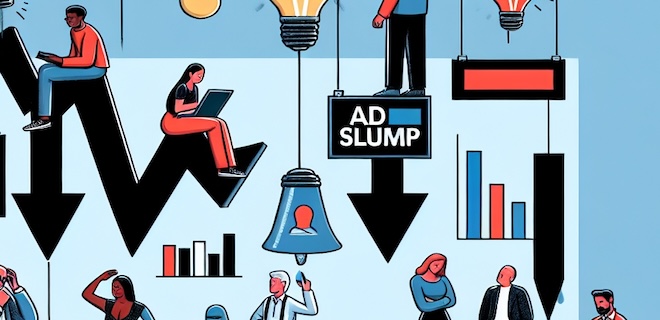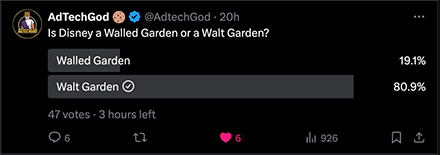| After the Election Windfall: How Publishers Plan to Survive the Ad Slump |
 |
| Election cycles bring publishers a windfall, both in readership and ad revenue. Political ad spending for the 2024 election cycle came in around $10.5 billion across various races, from presidential to local contests. With this influx now dried up, media consultant Matthew Goldstein’s warning of an “extinction-level event” looms over the media sector. Goldstein suggests that the campaign season provided a brief reprieve, but familiar challenges — third-party cookie deprecation, AI-driven search, and reader burnout — could soon shutter many publishers’ doors. Despite the $10.5 billion spent, major media companies, including Gannett, Time, Axios, Tampa Bay Times, NYPR, and the Hollywood Reporter, have announced layoffs amid declining ad revenue and shifting reader habits. So, how are publishers planning to stave off extinction? Survival may hinge on doing more with less — a central theme in AdMonsters' latest PublisherPulse, Amplify Your Audience. “The audience visiting publisher sites via Google is going to decline as AI-related search comes to the fore. Google Discover will continue for some time, but even that has potential to diminish. As a result, we have to find the next source of bringing new readers into our ecosystem,” said Josh Awtry of Newsweek. “The market is moving toward quality over volume, rewarding transparency, user-first ad setups, and attention metrics,” explains Emry Downinghall of Unwind Media. The report, featuring insights from eight publishers and industry experts, explores strategies to tackle today’s headwinds. A key takeaway? Publishers increasingly focus on quality over quantity—in both users and ads. — SS |
 |
| DoubleVerify Announced DV Attention for Publishers |
| Last Thursday, DoubleVerify (DV) introduced DV Attention for Publishers. This tool provides publishers with broad and detailed insights into their ad inventory and campaigns by measuring more than 15 specific attention-related metrics (such as engagement time, viewability, etc.). They analyze these metrics across at least 10 different dimensions or categories of inventory, such as ad unit types, device types, media types, etc. “With attention growing in popularity, publishers need actionable insights into inventory performance to maintain their competitive edge,” Steven Woolway, Executive Vice President of Business Development at DoubleVerify, said in DV’s press release. "DV’s attention offering equips our publisher clients with the data they need to understand how attention impacts campaign outcomes, leading to stronger partnerships with brands based on privacy-friendly metrics." — SS |
| Google Has Entered the Curation Chat—A Win for Advertisers or Just Another Tollbooth for Pubs? |
| Google just entered the latest ad tech chat—curation. They say if you’re not first, you better be best. With new services for advertisers in GAM, the tech behemoth is betting on the curation craze with hopes of making media buying simpler and more efficient. But will they achieve that goal, or are they just adding another middleman to the mix? You know, adding another tollbooth along the ad tech ecosystem highway. Digiday’s recent coverage breaks down Google’s plans to partner with top ad tech players while leveraging its ad server’s first-party data signals and deep connections across ad formats to attract advertisers. Big G’s blog announcement hints at how they plan to tackle the operational headaches that many agencies feel. Google’s curation tool aims to be the Marie Kondo for ads—consolidating scattered inventory into curated packages that advertisers can target directly based on real publisher signals, not just DSP data. To sweeten the pot, they rounded up a gang of trusted partners, including Integral Ad Science (IAS), who will add a brand safety layer. IAS’s tech promises to screen out low-quality, MFA content and bring AI-driven contextual targeting to the party—ideal for buyers looking to sidestep junk inventory. Sounds like they’re appealing to premium-conscious buyers, right? While this move might excite brands, many publishers have a skeptical take. Raptive’s Ryan Maynard outlined the publisher perspective for AdMonsters, where he raised concerns about extra fees, fewer direct sales, and the potential erosion of premium ad rates. Sure, these curated bundles can increase competition in private marketplaces (PMPs), but publishers are left wondering if the fees will dilute their margins. That sounds exactly like another tollbooth in an already crowded marketplace. That’s right, I said it again. There’s some broader skepticism bubbling up on LinkedIn. Media futurist Erez Levin raised a fair point, questioning the quality of Google’s inventory mix in these curated packages. He points out that while Google might boast massive reach, the quality of some of this inventory isn’t always up to snuff. Could it be more of a glittery promise than a golden ticket to premium ad placements? Levin’s advice? Buyers should keep their eyes open and treat curated inventory with a healthy dose of scrutiny. It’s too soon to call whether Google’s curation play is just another tollbooth or a real fix for ad tech’s signal-loss woes and targeting headaches. But it does suggest that curation isn’t just a fad—it’s a shift in who controls the flow of data and revenue. And as publishers and advertisers both weigh the costs, it’s clear this debate has only just begun. — LdJ |
| NYTimes Proves News Still Pays—If You’ve Got First-Party Data Muscle |
| Despite the chatter about the end of paid news, The New York Times is rolling in new subscribers—adding 260,000 digital-only subs this past quarter, topping the 11 million mark. How did the NYTs reach these third-quarter earnings stats? Their secret weapons were a playbook of first-party data and subscription-first models. Their revenue is just as telling: total earnings climbed 7% year-over-year to $640.2 million, with digital subscription revenue up 14.2% and digital ad revenue seeing an 8.8% bump. With everything from cooking apps to The Athletic, NYTimes has turned its platform into a lifestyle network, meeting readers wherever their interests lie. Think of it as news meets Netflix—a bundle where access keeps subscribers returning. Dotdash Meredith’s recent gains underscore this point. Its cookieless targeting solution, D/Cipher, drove digital ad revenue up by 12%. It’s proof that in a cookie-light world, first-party data is gold. And, the key to unlocking it? Consent and authenticated audiences, aka the drill rigs powering sustainable growth. Not everyone sees these results, though. WaPo, for example, lost 250,000 subscribers recently, showing that success requires more than data muscle—it’s also about nailing product and brand alignment. The takeaway for smaller publishers? Leaning into reader relationships and bundling value can go a long way, proving that, for now, news still pays. — LdJ |
| The EU Considering a $1 Billion Fine Against Apple for DMA Violations |
| Margrethe Vestager is nearing the end of her term as the EU’s Executive Vice President for A Europe Fit for the Digital Age. As she prepares to step down, she’s considering a dramatic parting move: issuing a $1 billion fine against Apple for alleged violations of the Digital Markets Act (DMA). Apple’s troubles began in June when EU regulators notified the company of alleged violations of the DMA. The European Commission wants to allow app developers to inform customers of cheaper alternatives outside the Apple Store, bypassing Apple’s 30% commission on in-app sales—a fee many EU developers are keen to avoid. To encourage competition, the DMA can levy big fines — up to 5% of average daily turnover — which in Apple’s case exceeds $1 billion. Apple said it began to comply with the DMA last August, when it announced changes to accommodate the DMA, including “changes to the browser choice screen, default apps, and app deletion for iOS and iPadOS for users in the EU” which, the company says, are the result of “our ongoing and continuing dialogue with the European Commission about compliance with the Digital Market Act’s requirements in these areas.” Are these changes enough? The fact that the EU is still considering a fine clearly indicates that the Commission isn’t quite convinced. If Vestager goes ahead with the fine, it will be the first in history. — SS |
| Russia Fines Google $20 Decillion |
| And speaking of fines, Putin isn’t happy that YouTube blocked Russian media outlets, and so a Russian court slapped Google with a hefty fine: $20 decillion (a decillion is a number that has 33 zeros). NBC News says the Kremlin admitted there is no expectation to be paid such a sum, and that it is a symbolic gesture. Still, it underscores the growing tensions between governments and major tech platforms over control, censorship, and influence. — SS |
 |
||||
|
||||
 |
||||
|
||||
 |
||||
|
||||
| @{optoutfooterhtml}@ |







